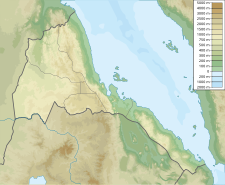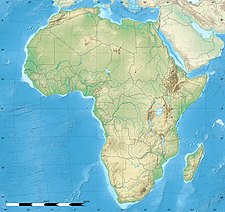Mosque of the Companions
| Mosque of the Companions | |
|---|---|
Masjid aṣ-Ṣaḥābah (مَسْجِد ٱلصَّحَابَة) | |
 | |
| Religion | |
| Affiliation | Islam |
| Location | |
| Location | Massawa, Eritrea |
| Geographic coordinates | 15°36′43″N 39°28′50″E / 15.61194°N 39.48056°E |
| Architecture | |
| Type | Mosque |
The Mosque of the Companions (Arabic: مَسْجِد ٱلصَّحَابَة, romanized: Masjid aṣ-Ṣaḥābah)[citation needed] is a mosque in the city of Massawa, Eritrea. According to local tradition, the mosque dates to the early 7th century CE and is believed by some to be the first mosque in Africa.[1]
History
[edit]Local Muslims generally believe that Massawa, particularly the small island known as Ras Medr off the city's coast,[2] was the place where the Companions (Arabic: الصحابة, romanized: Ṣaḥābah) of the Islamic prophet Muhammad landed in Africa when they fled persecution by non-Muslims in the Hejazi city of Mecca, present-day Saudi Arabia.[3] According to Richard J. Reid, the mosque may have been constructed in the 620s or 630s by members of Muhammad's family among this group.[1]
The present-day site consists of an open-air prayer area (a musalla) with a free-standing stone structure that consists of a mihrab (niche symbolising the direction of prayer) and an attached minbar (pulpit) that resembles a miniature minaret.[4] This latter feature is very similar to one found in the nearby Mosque of Sheikh Hammali, built in the Ottoman period, which suggests that the structure also dates from this period or later.[4][5]
See also
[edit]- List of mosques
- Al-Masjid al-Haram in Mecca
- List of mosques in Africa
- Al Nejashi Mosque, Ethiopia
- Lists of mosques
References
[edit]- ^ a b Reid, Richard J. (2012). A History of Modern Africa: 1800 to the Present. John Wiley & Sons. p. 106. ISBN 978-0-470-65898-7.
- ^ Miran, Jonathan (2009). Red Sea Citizens: Cosmopolitan Society and Cultural Change in Massawa. Indiana University Press. pp. 168 (see also 170, 190). ISBN 978-0-253-22079-0.
- ^ Miran, Jonathan (2021). "Massawa". In Fleet, Kate; Krämer, Gudrun; Matringe, Denis; Nawas, John; Rowson, Everett (eds.). Encyclopaedia of Islam, Three. Brill. ISBN 9789004161658.
- ^ a b Cantone, Cleo (2022). "A Historiography of Sub-Saharan African Mosques: From colonialism to modernity". In Østebø, Terje (ed.). Routledge Handbook of Islam in Africa. Routledge. pp. 72–73. ISBN 978-1-000-47172-4.
- ^ For the Sheikh Hammali Mosque, see: Cresti, Federico (1990). "Alcune Note Storiche Su Massaua, Con Particolare Riferimento Ad Un Complesso Religioso Islamico: La Moschea Dello Šayḫ Hammāli". Africa: Rivista trimestrale di studi e documentazione dell'Istituto italiano per l'Africa e l'Oriente. 45 (3): 410–431. ISSN 0001-9747. JSTOR 40760538.
External links
[edit]- "as-Sahaba Mosque - Madain Project". madainproject.com. Retrieved 2024-09-26.


